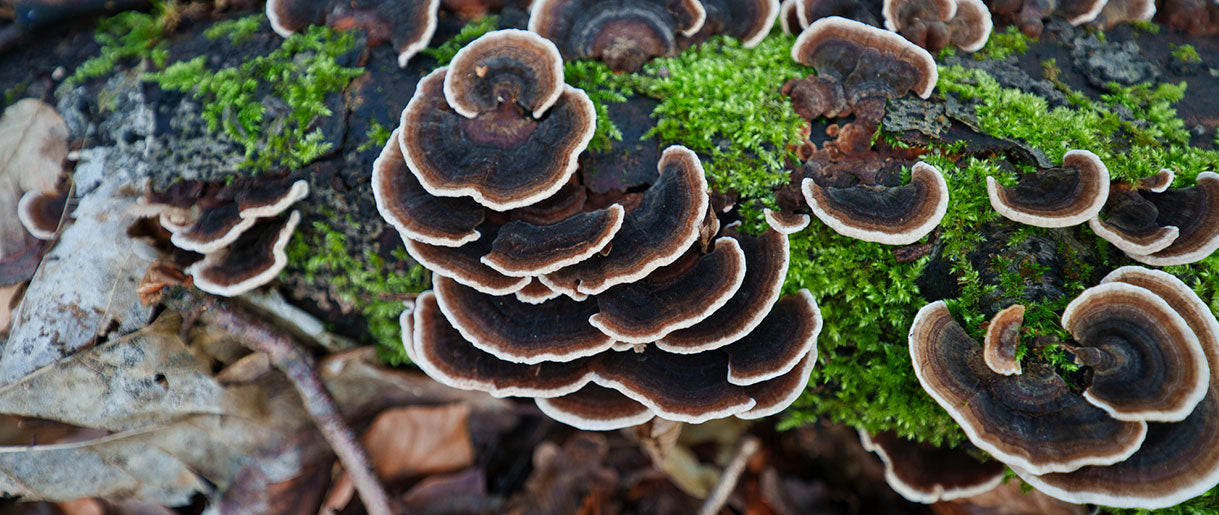Trametes versicolor, also known as Turkey tail(1), is a common polypore fungus that has gained popularity among all foragers and nature enthusiasts. These are also the most prevalent mushrooms in the woods. Even if you are not actively looking, you have most likely noticed them growing on fallen trees and stumps in the forest.
Although we've all seen them, there are many Turkey tail mushroom look alike, and their colors can vary greatly. Because of this, you should really pay close attention to the details to make sure that what you have is genuine.
Turkey tail identification identifying can be trickier than expected, but these few tips will help you decide if your Turkey tail is indeed what you think it is.
So, we’ll talk about Turkey tail mushroom identification and the difference between Turkey tail vs false turkey tail.
How To Identify Turkey Tail Mushroom?

The many health benefits of Turkey tail have quickly made it of the most popular consumer mushrooms on the market! However, while we could go to the store and buy Turkey tail, we would miss the chance to spend time outdoors foraging for it (and saving money!)
Numerous mushrooms resemble this fungus, so it's crucial to understand Turkey tail mushrooms identification before using them (or any other foraged good) so you can be 100% sure.
The following steps are a great starting point to avoid false Turkey tail mushroom identification. So, the next time you go for a walk in the woods, you can utilize your newly acquired mushroom deduction abilities to your advantage. Then, take some fresh Turkey tail home to create a nutritious tea if you choose to forage what you find.
Turkey Tail Identification

Trametes versicolor, which means “of various hues,” never fails to catch the attention of many onlookers. Turkey tail mushrooms are not only attractive to the eye, but they are also easy to find! Like many other pastimes, accurate mushroom identification can be challenging and needs practice to become reliable. However, you can rule out some of the most popular false Turkey Tails with the help of a quick identification checklist. The following four stages are quick and straightforward to remember and will be helpful for your mushroom-hunting expeditions!
1. To begin with, turn your presumed Turkey tail mushroom over and check for the presence of tiny pores. The underside of Turkey tail mushrooms should be porous; if it is smooth, the mushrooms might be "false Turkey tails."
2. Next, look more closely. How large are the pores' sizes? To be considered true Turkey tail mushrooms, the pores must be exceedingly small, with 3 to 8 pores per millimeter. An excellent tip for measurement would be to use a ballpoint pen. With the tip pointing up, place the pen near the pores. The tip should cover at least or more than three pores. It could be a different species of Trametes if it just covers two to three spots. If it does, you've probably discovered a Turkey tail!
3. Finally, touch the mushroom's surface. It should have a velvet-like texture that is just a little bit fuzzy. As mushrooms age, they become hard and rigid, so true Turkey tail mushrooms should also be thin and flexible. This can also help you determine how fresh the mushrooms are. You could be looking at Trametes ochracea if it is firm or rigid.
4. Pay attention to the mushroom tops. Do rings come in different colors? If so, a true Turkey tail should be easily identifiable by its sharply contrasting and distinct hues.
Now, to find the real deal, use the four points on our checklist below. You have discovered an authentic Turkey tail if you can say "YES" to each of the following questions regarding the mushroom you are looking at.
1. Does the underside of your mushroom have pores?
2. Does the mushroom's top contain extremely fine hairs that feel velvety to the touch?
3. Are there different shades of concentric stripes on the mushroom's top side?
4. Is the fresh mushroom paper thin and flexible?
It's most likely a true Turkey tail if you responded positively to each of these questions. One thing to keep in mind is that the look of the fungi varies greatly depending on factors like age, exposure to sunlight, season, etc. Look at more than just the first photo you find if you believe you have a Turkey tail because there may be some color variations.
Turkey Tail Vs. False Turkey Tail

Things can be more puzzling because several other mushrooms greatly resemble Trametes versicolor. These imposters, also known as "false turkey tail mushrooms," include Trichaptum abietinum, Stereum ostrea, and Stereum hirstum.
What distinguishes "true" from "false" Turkey tail mushrooms? Flip a mushroom over if it appears to be Trametes versicolor while hiking. True Turkey tail fungi are categorized as polypore (many pored) mushrooms because of the obvious pores on their white underside.
FAQs About Turkey Tail Mushroom Identification
Does Turkey Tail Have Any Poisonous Look Alikes?
Fortunately, there are no toxic lookalikes of the mushroom, and foraging for it is safe, even if you don't find "the real thing." But although some mushrooms resemble Turkey tail, they do not have the same beneficial compounds.
Is It Safe To Take Turkey Tail Mushroom?
Turkey tail mushrooms are likely safe and well-tolerated by most adults. You can take the mushroom every day. Just make sure you stick to the recommended dosages.
What Is The Turkey Tail Mushroom Taste Like?
According to some, the taste of Turkey tail mushrooms is mild compared to Reishi or Shiitake. Some describe the flavor as somewhat earthy and bitter but not mushroomy.
Key Takeaways
Turkey tail mushroom identification can be challenging for beginners, but with some understanding of the features that set it apart, it can be distinguished from its lookalikes! This wood-decay mushroom has pores on the underside, with about three pores per tip of a ballpoint pen. In addition, the mushroom has a silky, fuzzy top and bends with minimal effort.
References
- Trametes versicolor (Synn. Coriolus versicolor) Polysaccharides in Cancer Therapy: Targets and Efficacy, (1)https://pubmed.ncbi.nlm.nih.gov/32466253/









Let Us Know Your Comments